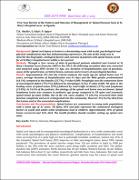| dc.identifier.citation | Okello, T. R., Odul, E., & Opiyo, P. (2015). Five year review of the pattern and outcome of managment of spinal diseases seen at St. Mary's Hospital Lacor in Uganda. East and Central African Journal of Surgery, 20(3), 86-94. | en_US |
| dc.description.abstract | Background: Spinal cord injury or lesion is a devastating event with social, psychological and
physical ramifications that has dehumanizing experiences. The aim of this study was to
describe the biographic, etiological factors and outcome of patients with spinal lesions cared
for at St Mary’s hospital Lacor within a 5yrs period.
Methods: Through a 5yrs review of data of paralyzed patients admitted and treated at St
Mary’s hospital Lacor from Jan 2009 to Dec 2013, the following secondary data was extracted
and analyzed using SPSS version 15: Age, sex, duration of hospitalization, type of paralysis,
cause of the spinal lesion, vertebral lesion, outcome and recovery of neurological function.
Results: Approximately 241 met the criteria analysis, the mean age for spinal lesion was 31
years, average duration of hospitalization was 61 days and the Male gender predominated
(64.3%) compared to the females (35.7%), P-value 0.000. Paraplegia was the commonest form
of neurological deficit (79.67%) followed by tetraplegia (13%), P-value 0.000. TB spine is the
leading cause of spinal lesion (19%) followed by road traffic accidents (17%) and lymphoma
(15.8%). In 16.6% of the patients, the etiology of the spinal cord lesion was not known. Spinal
lymphoma lesion was common in pediatric age group compared to TB spine and traumatic
spinal lesion (p-value 0.000). Out of the 241 cases studied, 73 (30.3%) recovered their limb
function completely and were reintegrated into the community. However 39 (16.2%) died from
the lesions and/or the associated complications.
Conclusions and Recommendation: Spinal lesions are commonest in young male populations
with a mean age of 31 years. TB Spine, RTA and falls represent the commonest etiological
factors in youth and adults while lymphomas lead in children. Approximately 30% of spinal
lesion recovered and 16% died. The health facilities should consider setting up spinal care
units | en_US |

